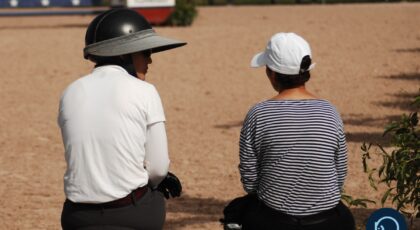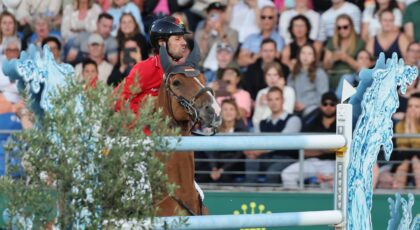Division I collegiate riding coach Sally Batton has spent over 30-years perfecting her methods specifically designed to refine and polish riders, whatever their level. It has won her and her teams ribbons, trophies, and championships. Sally knows what we tend to get wrong while in the saddle—over and over and over again—and she has found unique ways to interrupt the “flow of ‘No!’” with easy-to-use hacks. In this excerpt from the book The Athletic Equestrian, which Sally wrote with fellow collegiate coach Christina Keim, you learn a quick and easy trick for keeping your eyes and head up (one of those over-and-over-again issues) while we ride.
***
If a rider wants to execute smooth, effortless transitions and ensure invisible communication with her horse on the flat and over fences, breaking the bad habit of dropping her head and looking down is essential.
If you have ever given a child or friend a piggyback ride or carried them on your shoulders, you know firsthand how disruptive that extra, mobile weight is to your balance. In order to stay upright with this burden, you must keep your head up and stack your shoulders over your hips. If your “rider” tips forward, you immediately scramble to keep your collective balance or risk falling.
Horses are rear-wheel-drive: Their power is in their hindquarters, and they need to do both upward and downward transitions from the hind end first. When the rider habitually looks down, it has the effect of causing the horse to run on his forehand. With extra weight on the forehand (and the horse naturally already carries as much as 60 percent of his weight there), rear-wheel-drive transitions are not possible. The horse, figuratively, just spins his wheels.
My number one Teaching Tool to help riders break their old habit of looking down are what I call Eyes-Up Goggles. Eyes-Up Goggles are one teaching tool that you will not have to make! Visit your local sporting goods or department store (or order online), and look for “basketball dribbling glasses.”
These specialized sport glasses are usually black, made of soft rubber with an adjustable strap, and sold singly or in packs. The bottom half of the “glasses” is blacked out with a half-moon of rubber. The wearer can still see, but if she looks down, all she sees is the black rubber. The best part is they are not expensive; I usually spend less than $5 on a pair. (Note that, unfortunately, Eyes-Up Goggles don’t work great over eyeglasses, as the latter will fog up.)
When a rider habitually looks down, she is usually not aware she is doing so. But when she wears Eyes-Up Goggles, she is reminded—immediately—when her eyes leave their designated focal point out ahead of her. Eyes-Up Goggles are also useful for a rider learning to feel for her posting diagonals and canter leads, because if she tries to confirm them visually, all she will see is the black rubber.
I have riders use Eyes-Up Goggles for about 15 minutes, then pull the Goggles down and wear them like a necklace while they practice maintaining the feeling. This way, the Goggles are readily available to put back in place when needed.

This excerpt from The Athletic Equestrian by Sally Batton and Christina Keim is reprinted with permission from Trafalgar Square Books (www.HorseandRiderBooks.com).


 April 14, 2022
April 14, 2022 

























